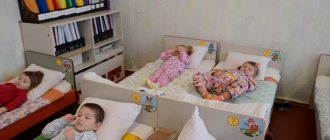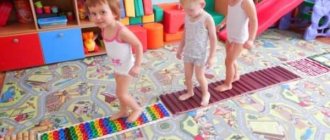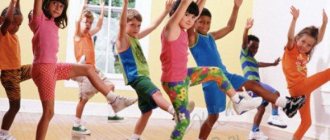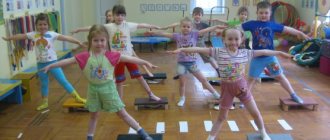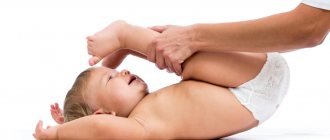Gymnastics after sleep in the senior group
Short-term gymnastics after a nap helps educators maintain a healthy mind in a healthy body and invigorate the child. She carefully and smoothly helps children wake up, fill themselves with strength and vigor.
Invigorating gymnastics after sleep
What is it and what is it for?
Gymnastics after sleep in the older group is a set of exercises that helps children gradually move from a state of rest to wakefulness. On average, older preschoolers are given an average of 5 to 8 minutes to do exercises after waking up.
Gymnastics is necessary for the following:
- effective awakening;
- improving mood and emotional state;
- health promotion;
- prevention of colds;
- increasing muscle tone;
- preventing the development of disorders in the musculoskeletal system, scoliosis and flat feet;
- formation of healthy lifestyle habits.
Important! The teacher must closely monitor the performance of the exercises and explain to the students that they must be performed smoothly, without sudden movements. Otherwise, muscle strain and dizziness may occur.
The main purpose of exercises after a nap is to prevent irritability in preschoolers (if they still want to sleep), anxiety and the formation of a favorable emotional background in the group, as well as to improve and develop coordination of movements in children.
In order to achieve the desired results from a set of exercises, it is very important to carry them out correctly. It is recommended to draw up lesson notes taking into account those that preceded them. Immediately after waking up, the teacher should set the students up to do the exercises. When performing them, the room temperature should be maintained at 16 to 18 degrees. If some students wake up earlier than others, it is recommended to come up with additional activities for them that they can do. Children are not recommended to go barefoot during ARVI outbreaks.
Elements of gymnastics after sleep
Gymnastics after sleep is like a multi-colored mosaic that can be reassembled every day, creating a new image from its main elements. Daytime gymnastics, as an option, may include:
- stretching;
- breathing exercises;
- swing your arms;
- stroking biologically active zones;
- jumping;
- squats;
- simple elements of yoga;
- finger gymnastics;
- gymnastics for the eyes;
- visual-acoustic exercises.
Despite the fact that gymnastics after sleep is usually short-lived, the teacher can combine individual elements and use the developments he likes in fragments.
Video example of morning exercises:
Methodology for conducting invigorating gymnastics in preschool educational institutions
In order for gymnastics after sleep in the older group to bring the expected results, it must combine several types of exercises. It is not recommended to include strength or endurance exercises in your post-sleep activities. The adequacy of the chosen load can be assessed by the children’s well-being after performing the exercises. If exercises invigorate, make children energetic and cheerful, then the load is optimally chosen.
Note! In the senior group of kindergarten, pupils can repeat previously learned exercises without a teacher, since at this age children have a very developed memory.
Methodology for conducting invigorating gymnastics in preschool educational institutions
Making a time plan
To maintain children's interest and emotional state, it is recommended to adhere to a time plan that regulates the implementation of each block.
After waking up, exercises are carried out in bed for 1.5-2.5 minutes. Then a transition is made to the active block, which involves performing gymnastics near the cribs. Its duration should vary from 2 to 3 minutes. After this, breathing exercises are performed for several minutes. The complex is completed by walking for one minute on massage mats.
The role of physical education
Summary of awakening gymnastics in the senior group
When compiling notes, many teachers in the middle group of kindergarten prefer to use the book “Physical Culture of Penzulaev 4-5.” It describes in detail all the exercises that help preschoolers develop physically correctly, be cheerful and vigorous.
Note! When compiling notes, it is important to understand that the main goal of the classes is to form the habit of a healthy lifestyle and independent exercise at home.
Exercise after sleep
Charging analysis
To get a general impression of the effectiveness of children's gymnastics after wake-up in the older group, it is necessary to regularly conduct analysis. The development of the analysis scheme is carried out by the methodological team of the kindergarten. Monitoring is carried out every month and determines how effectively certain techniques are used.
When conducting an analysis, an analytical report must be written, which indicates the name of the preschool educational institution, the name of the teacher, the age of the students and their number, and necessarily the date of the gymnastics. After this, the results of the activity are directly entered into.
On the topic: methodological developments, presentations and notes
Card index of invigorating gymnastics after a nap for children of senior preschool age.
Complexes of invigorating gymnastics after naps for older children.
Gymnastics summary after nap in the senior group.
Age group: senior Goal: Promote awakening after a nap, tone the entire body. Promote awakening after a nap, tone the entire body. Promote testing.
Source
Complexes of health-improving gymnastics after sleep for children 5-6 years old
Health-improving gymnastics in the senior group has acquired particular relevance in recent years. This is explained primarily by the fact that the health of preschool children has steadily deteriorated. The set of exercises after sleep should include only gentle exercises and hardening elements.
Note! It should be performed only by those children who have no contraindications or restrictions to their implementation.
Gymnastics in bed
Before starting charging, the teacher must carefully prepare the room. He should open the curtains, open the window, especially in summer, spring and autumn, and play a quiet melody. For older children, the following exercises in bed are recommended:
- Stretching - children lie on their backs and lower their arms along the body. Then, one by one, they raise their arms up and stretch.
- Self-massage of the head - the teacher asks the children to sit on the bed and imitate washing their hair.
- We rest - the pupils lie on their stomachs with support on their elbows. The chin is supported by the palms. The teacher asks the children to alternately bend and straighten their knees.
Note! Exercises in bed help to gradually restore muscle tone after sleep and prepare them for active action.
Gymnastics in bed
Prevention of flat feet
Special attention is paid to the prevention of flat feet in preschool institutions, since this disease has become very common among children. Children's age is more favorable for correcting the feet. After sleep, orthopedic massage mats are used in kindergartens for prevention purposes. Children walk on them barefoot immediately after their nap.
Prevention of postural disorders
Children should develop correct posture from an early age, so it is very important that children in preschool institutions perform special exercises aimed at preventing scoliosis. The main measures that will help prevent postural disorders are considered to be a set of exercises aimed at improving it.
Morning exercises for kids with music
Note! Preschool children are recommended to perform special exercises while standing near a vertical plane. Therefore, many educators prefer to do exercises with children after sleep near their cribs.
Breathing and sound gymnastics
A set of special exercises that are aimed at improving health and developing the child’s ability to relax is classified as breathing and sound gymnastics. The main goal of the teacher when performing such exercises is the desire to teach each child to breathe deeply and correctly, to be able to coordinate their own movements, to develop the speech apparatus and to cheer up after a nap.
Among other things, elementary exercises help to form the sound culture of speech and correct sound pronunciation disorders in childhood. The following exercises are considered the most common and effective:
- "Watch."
- "Cockerel."
- "Pump".
- "Semaphore".
- "Merry little engine."
Note! If a child has no speech problems at all, there is no point in giving up sound-breathing exercises in kindergarten, since the exercises will never hurt.
Breathing exercises
Types of gymnastics after sleep
In the methodological developments proposed by experts, the following types of gymnastics after sleep can be distinguished:
- exercises in bed with elements of self-massage;
- play gymnastics;
- gymnastics with exercise equipment and sports equipment;
- walking or jogging on massage mats/paths.
When preparing the exercise, you can use any exercise equipment that is available in the kindergarten
. As can be seen from the list, daytime gymnastics becomes a powerful set of health procedures, competently and concisely structured in time, and most importantly, interesting and enjoyable for the child.
All exercises are carried out in stages, with a gradual increase in load, and are of a playful nature. They are aimed at general strengthening of the body, prevention of disorders of posture, vision and flat feet. Psychologically, gymnastics classes unite children in a group and help them get out of the state of internal stiffness into which, as if in a capsule, the baby is immersed during sleep.
The teacher is free to choose specific exercises. He independently assesses the capabilities and needs of his students, observes which exercises are especially loved by children and, if desired, varies the tasks so as not to turn the magic of the five-minute sports session into a routine.
Preview:
What is it that we hear? It's rain knocking on the roof. And now he went harder, and hit the roof faster (they hit the palm of the other with the pads of the fingers of one hand). Let's raise our hands up and reach the cloud (raise our hands up, stretch) Get away from us quickly, don't scare us children (waving their hands)
Now the sun has come to us, It has become cheerful, light (turn their head to the right, to the left). And now let’s stand on our feet, And become big (I.p. feet shoulder-width apart, arms along the body. Raise clasped hands up - inhale, lower down - slowly exhale with the pronunciation of the word Uh-h-h).
Tili-tili-tili-don, What a strange chime. Then our alarm clock rings, telling us to wake up.
I'll push the remnants of sleep away. Blanket to the side. We need gymnastics. It helps a lot.
We woke up and stretched. Turned from side to side,
And they pulled back. And one more time, they turned from side to side, and reached back.
We raised our legs and stood on the pedals. I pedal faster, and I rock, I rock, I rock. We found ourselves in a meadow. Motley wings flutter, These are butterflies flying.
Let's stand by the crib together. And we'll look out the window. A rooster walked through the yard and shouted to us “Ku-ka-re-ku!” He flapped his wings and stomped his feet.
Well, in response to him, we will all shout “Ku-ka-re-ku!” Our legs, our legs We ran along the path.
(Movements are performed in accordance with the words).
As a result of this approach to this regime moment, we see:
– awakening is painless for the child; – it is easily included in game exercises; – receives a positive emotional mood; – easily moves on to play activities.
Prepared by: music director
Awakening is one of the most important moments contributing to the normal course of vital processes for the child. For this purpose, after daytime sleep, gymnastics is performed in bed; it is aimed at a gradual transition from sleep to wakefulness.
Children wake up to the sounds of smooth music. We start doing gymnastics with the children who wake up, the rest join in as they wake up.
